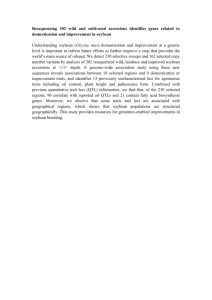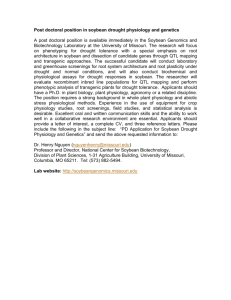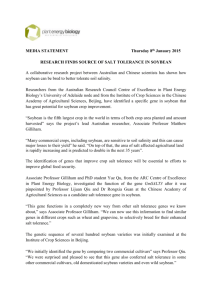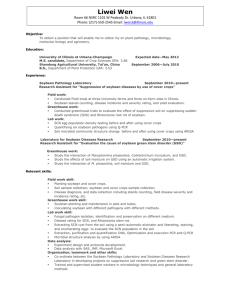tpj13069-sup-0015-Legends
advertisement
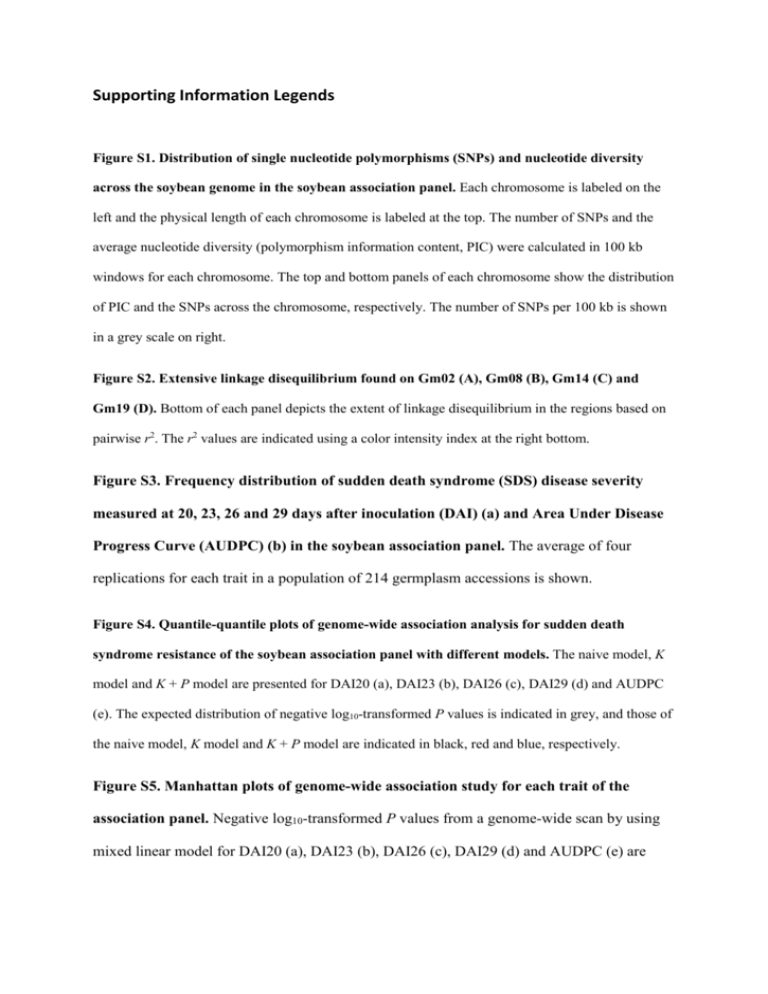
Supporting Information Legends Figure S1. Distribution of single nucleotide polymorphisms (SNPs) and nucleotide diversity across the soybean genome in the soybean association panel. Each chromosome is labeled on the left and the physical length of each chromosome is labeled at the top. The number of SNPs and the average nucleotide diversity (polymorphism information content, PIC) were calculated in 100 kb windows for each chromosome. The top and bottom panels of each chromosome show the distribution of PIC and the SNPs across the chromosome, respectively. The number of SNPs per 100 kb is shown in a grey scale on right. Figure S2. Extensive linkage disequilibrium found on Gm02 (A), Gm08 (B), Gm14 (C) and Gm19 (D). Bottom of each panel depicts the extent of linkage disequilibrium in the regions based on pairwise r2. The r2 values are indicated using a color intensity index at the right bottom. Figure S3. Frequency distribution of sudden death syndrome (SDS) disease severity measured at 20, 23, 26 and 29 days after inoculation (DAI) (a) and Area Under Disease Progress Curve (AUDPC) (b) in the soybean association panel. The average of four replications for each trait in a population of 214 germplasm accessions is shown. Figure S4. Quantile-quantile plots of genome-wide association analysis for sudden death syndrome resistance of the soybean association panel with different models. The naive model, K model and K + P model are presented for DAI20 (a), DAI23 (b), DAI26 (c), DAI29 (d) and AUDPC (e). The expected distribution of negative log10-transformed P values is indicated in grey, and those of the naive model, K model and K + P model are indicated in black, red and blue, respectively. Figure S5. Manhattan plots of genome-wide association study for each trait of the association panel. Negative log10-transformed P values from a genome-wide scan by using mixed linear model for DAI20 (a), DAI23 (b), DAI26 (c), DAI29 (d) and AUDPC (e) are plotted against positions on each of the 20 chromosomes. The significant trait-associated SNPs are distinguished by the threshold line and are colored in red. Figure S6. Manhattan plots of genome-wide epistasis (SNP-SNP interaction) study for each trait of the association panel. The maximum negative log10-transformed P values of one SNP for each SNP-SNP interaction associated with DAI20 (a), DAI23 (b), DAI26 (c), DAI29 (d) and AUDPC (e) are plotted against positions on each of the 20 chromosomes. The significant trait-associated interactions are distinguished by the threshold line (P < 1.0×10-10 or Bonferroni P < 0.05) and are colored in red. The plots only show interactions with P < 1×10-5. Figure S7. Allelic distribution of the 12 identified additive loci associated with SDS-resistance in a sample of 96 elite soybean cultivars. The pink area in a pie chart indicates the proportion of the elite cultivars carrying the desired allele at the specific locus. Figure S8. Allelic distribution of the 12 identified epistatic loci associated with SDS-resistance in a sample of 96 elite soybean cultivars. The pink area in a pie chart indicates the proportion of the elite cultivars carrying the desired haplotype at the specific locus. Table S1. List of the 214 PIs of the soybean association panel, their country origin and maturity groups. Table S2. Phenotypic variation for sudden death syndrome disease expression in the soybean association panel. Table S3. Correlation coefficients between different time-point measurements of sudden death syndrome disease resistance in the soybean association panel. Table S4. Bayesian Information Criterion (BIC) values of mixed linear model with different numbers of principal components (PCs) used for association analyses of each measurement of sudden death syndrome resistance in the soybean association panel. Table S5. Allelic analysis of the sudden death syndrome resistance associated loci in the PI 82278. Table S6. List of the observations of SDS resistance of the 214 PIs in a greenhouse test with 4 replications.
